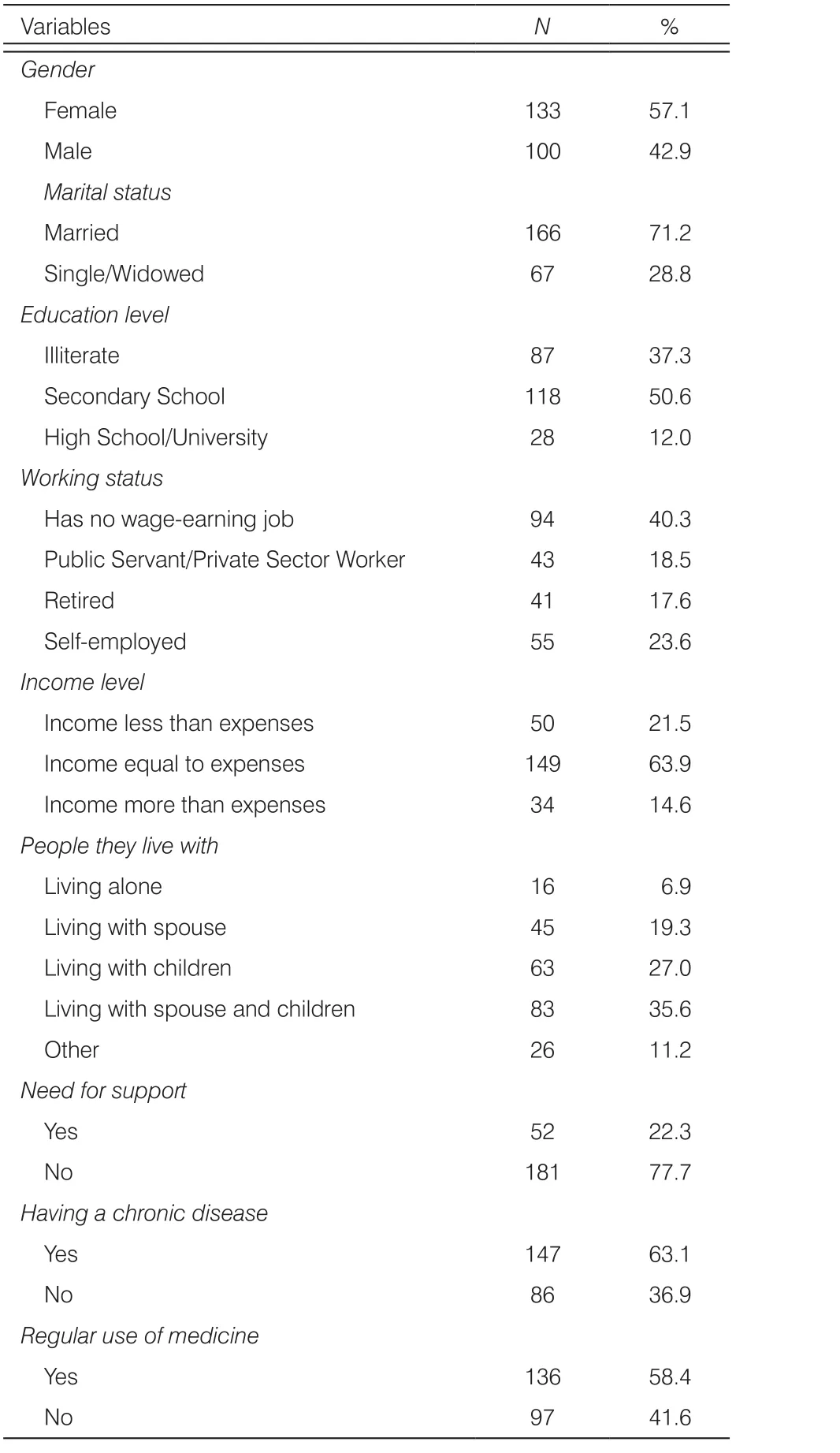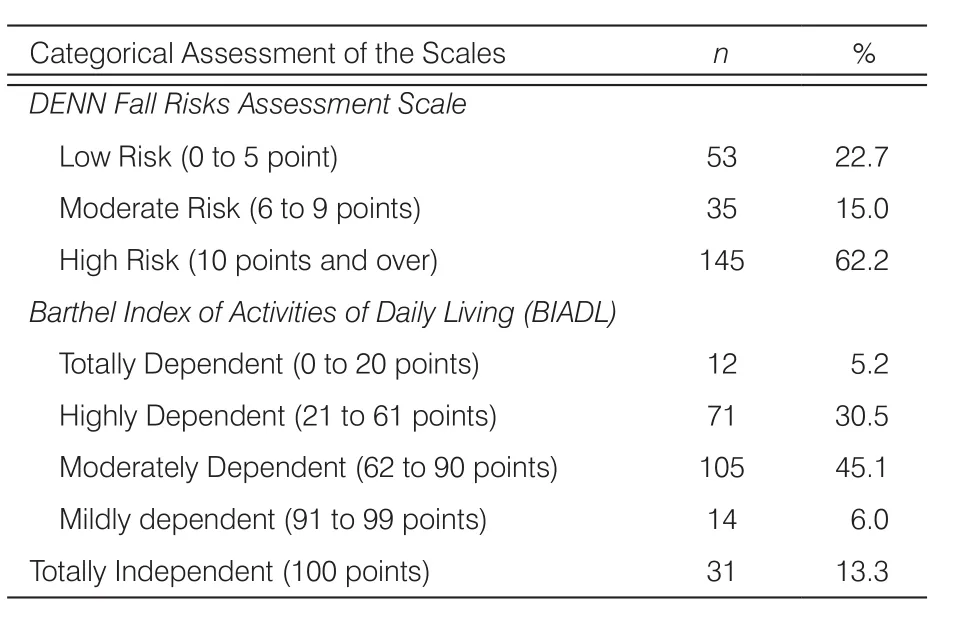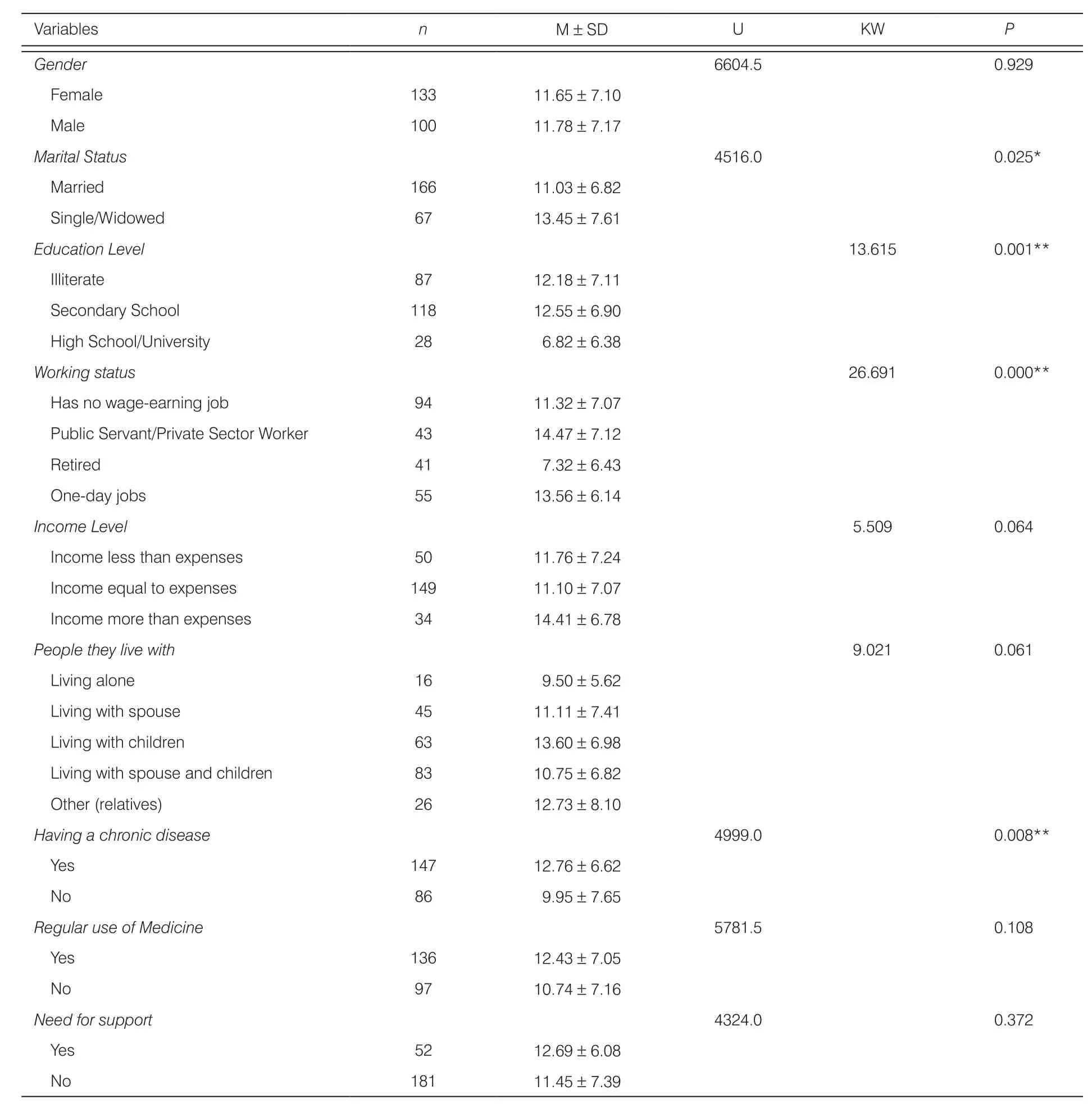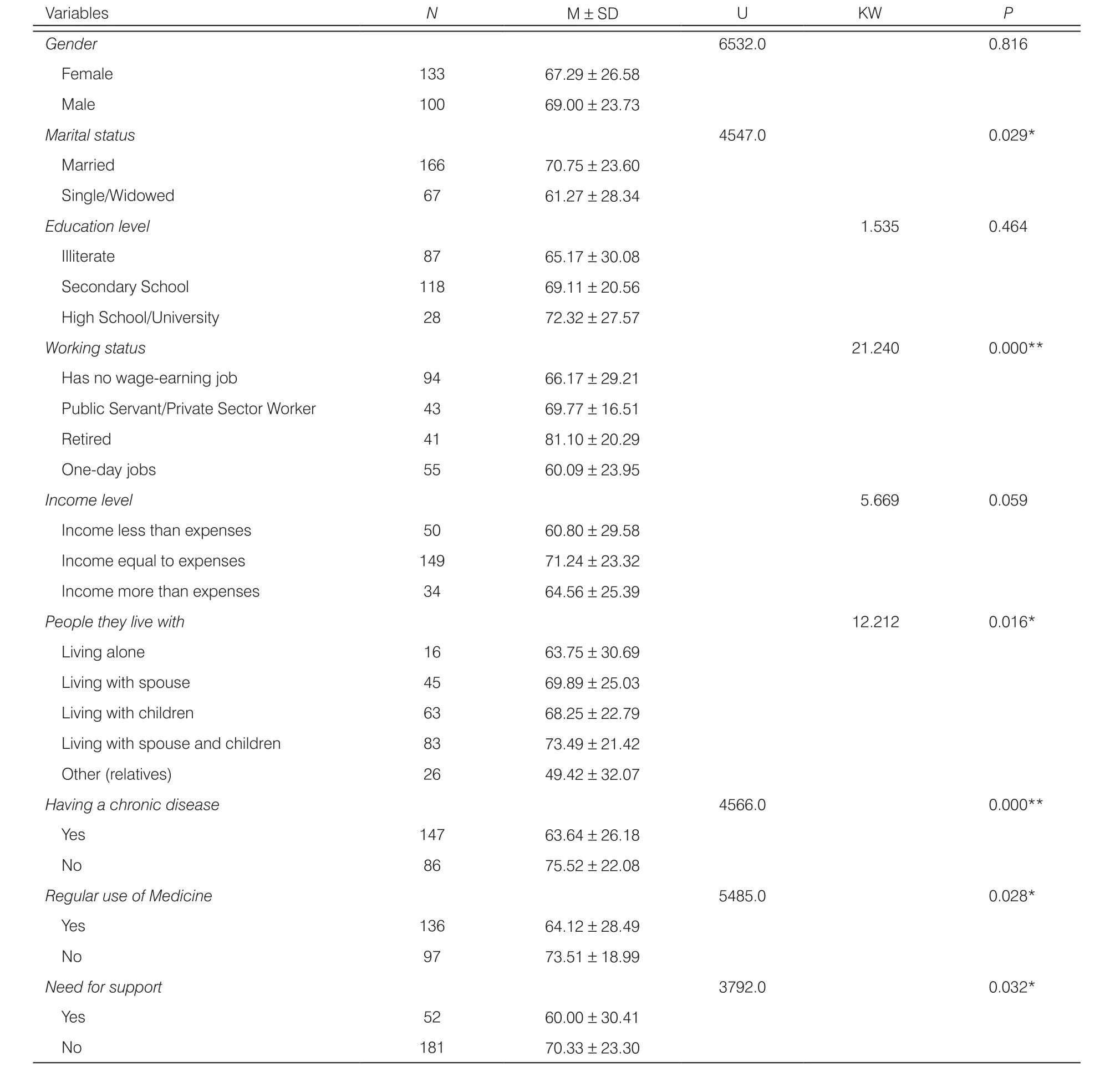Relationship between fall risks and activities of daily living in older individuals
Senay Karadag Arli*, Metin Yildiz, Ayse Berivan Bakan
Department of Nursing, Agri Ibrahim Cecen University School of Health, Agri 04100, Turkey
Abstract: Objective: To investigate the relationship between fall risks and maintaining activities of daily living in individuals aged 65 and over.
Methods: This study is cross-sectional. It was conducted with 233 individuals who were aged 65 and over in Family Health Centers located in the eastern part of Turkey between February and June 2018.
Results: The mean older individuals’ DENN Fall Risks Assessment Scale score was 11.73 ± 7.13, and 62.2% of the participants were in the high-risk group. Barthel Index of Activities of Daily Living (ADL) mean score was 68.03 ± 25.36, and 45.1% of the participants were in the moderately dependent group. There was a statistically signi ficant, negative correlationship between Barthel Index of ADL score and age and DENN Fall Risks Assessment Scale score. In addition, there was a statistically signi ficant, positive relationship between the DENN Fall Risks Assessment Scale score and age (p < 0.01).
Conclusions: This study found that level of dependency and fall risks increased with the increase in age. Effective global and multidisciplinary interventions are needed to decrease older individuals’ dependency levels and fall risks today when the number of older individuals is increasing.
Keywords: activities of daily living · dependency · older · fall risk
1. Introduction
The global increase in the older population has also increased the pressure on the health systems and services required for the care and treatment of older individuals. Demographic trends in the following 30 years show that the adult population aged 65 and over will become nearly 2 billion by the year 2050.1,2The proportion of older individuals has been increasing rapidly in Turkey like in the world. While 8.7% of the world population is composed of an older population, this proportion was 8.3% in Turkey in 2016.3Number and proportion of older individuals in the total population make old age an important social problem in modern society. Increase in individuals’ life expectancy brings along problems such as health problems that prevent older individuals from taking care of themselves, becoming dependent on others, and requiring care.4,5
With the aging process, older individuals experience biological, psychological, and physiological declines and dif ficulties in activities of daily living (ADL) as well as visible insuf ficiency in their functions. These changes experienced by older individuals limit the ADL and negatively affect their quality of life.6,7In the 1970s,Nancy Roper, Winifred W. Logan and Alison J. Tierney developed a Nursing Model, based on ADL, that provides a systematic presentation of ADL and a rational method of approaching human beings with all dimensions to identify the importance of ADL. ADL presents individuals’ activities that they carry out to maintain daily life. The main notion of this model is to identify the extent to which people can maintain their daily life independently on their own.8
Older individuals’ self-suf ficiency decreases gradually as their health problems increase, and there are increases in accidents and fall rates. Although falls are not speci fic to old age, it is an important health problem whose prevalence increases with age and which causes mortality and morbidity in older individuals.9,10Globally,approximately one-third of individuals aged 65 and over fall annually, and 20-30% of these falls result in physical injury. In addition, severe injuries in older individuals increase care costs.11,12Falls are the primary causes of fatal and nonfatal injuries in individuals over 65 years old. In America, approximately 27,000 older individuals died due to falls in 2014; 2.8 million patients were treated in emergency services due to injuries caused by falls, and approximately 800,000 of these patients were hospitalized.13
With the aging process, older persons experience regression, with visible insuf ficiency, and dif ficulty in daily living activities. These changes in elderly persons restrict the daily living activities of individuals, with negative impacts on their quality of life. In particular, falls represent a phenomenon that causes fear and concern in older persons. Although falls are not limited to older persons, it is an important health issue the prevalence of which increases with age, causing mortality and morbidity in older persons. However, the literature states that fall risk increased in older persons, particularly those under treatment at hospitals, and increased subject to deterioration of medical conditions, polypharmacy,environmental factors, and confusion. Also, the fear of falling affects the feeling of con fidence in older persons in relation to their daily activities, reducing their ability to perform daily living activities and leading to a less active lifestyle.14,15
Study results showed that physical performance is very important for the realization of stability and flexibility in the older. It suggests taking part in older rehabilitation of the applications for the protection and improvement of body flexibility and balance.16Another study result recommended that “Safe-Movement and Walking Program” is generalized and more applied in nursing homes for decreasing fear of falling in the older individuals living in a nursing home.17
2. Materials and methods
2.1. Study design
This cross-sectional study was conducted in Family Health Centers located in Ağrı city center between February and June 2018.
The target population of the study were individuals who were aged 65 and over who lived in Ağrı. No sampling was performed, the study involved 233 individuals who applied to Family Health Centers;who did not have Alzheimer’s, dementia, paralysis, or terminal cancer; who had suf ficient communication skills; and who volunteered to participate in the study.
2.2. Data collection
Data were collected using the Socio-demographic Form,DENN Fall Risks Assessment Scale, and Barthel Index of ADL (BI). Data were collected by the researchers via face to face interviews conducted with older individuals.Data collection took approximately 15 to 20 minutes.
2.2.1. Socio-demographic form
The form, which was prepared by the researcher in line with the related literature, was composed of seven questions that aimed to collect information about age,gender, marital status, and income level.18,19
2.2.2. DENN Fall Risks Assessment Scale
The scale is composed of nine main sub-scales developed by Nebraska’s Medicare Quality Improvement Organization by bene fiting from the Falls Management Guidelines.20The form was adapted to Turkish by Tekin et al.21The total score Kappa value of the scale was found 0.753. Assessment is made according to the total score, and the individual’s fall risk is identi fied accordingly. Scores are categorized as “low risk” for the scores between 0 and 5, “moderate risk” for the scores between 6 and 9, and “high risk” for the scores 10 and above.21Cronbach’s Alpha value was found 0.79 in the present study.
2.2.3. Barthel Index of ADL
Barthel Index, developed by Mahoney and Barthel in 1965, investigates patients’ independency level in ADL.22Validity and reliability of the scale for Turkey was performed by Küçükdeveci et al.23with neurology patients; Cronbach’s Alpha value was found 0.93.23Barthel Index is used for the identi fication of individuals’ independency levels in their activities.Barthel Index scores range between 0 and 100; while 0 indicates total dependency, 100 indicates independency. According to Barthel Index, scores between 0 and 20 indicate dependent individuals; scores from 21 to 61 indicate highly dependent individuals,scores from 62 to 90 indicate moderately dependent individuals, and 100 indicates independent individuals.22,23Cronbach’s Alpha value was found.88 in the present study.
2.3. Analysis of the data
Data were analyzed using SPSS statistical package.The analysis was performed using descriptive statistics,Kolmogorov-Smirnov, Mann-Whitney U, Kruskal-Wallis,and Spearman correlation tests.
2.4. Ethical considerations
Approval was obtained from Ağrı İbrahim Çeçen University Scienti fic Research Ethics Committee and written permission was obtained from the institution where the study was conducted (City Health Administrative).The participants were provided with the necessary explanations, and verbal consent was obtained from those who accepted to participate in the study.
3. Results
Of all the participants, 57.1% were female, 71.2% were married, 50.6% graduated from secondary school,40.3% did not have a wage-earning job, 63.9% had income equal to expenses, 35.6% lived with their spouse and children, 77.7% did not need support about anything, 63.1% had a chronic disease, 58.4% used medicine regularly, and the average age of the group was 70.18 ± 7.09 (Table1).
Findings showed that older individuals’ DENN Fall Risks Assessment Scale mean score was 11.73 ± 7.13;scores ranged between 0 and 27. Categorical analysis of the scale score showed that 62.2% of the participants were in the high-risk group. Barthel Index of ADL mean score was 68.03 ± 25.36 with scores ranging from 0 to 100. Categorical analysis of the scale score showed that 45.1% of the participants were in the moderately dependent group (Table 2).
DENN Fall Risks Assessment Scale mean score was found to be signi ficantly higher in those who were single/widowed, who graduated from secondary school,who worked in public/private sector, and who had a chronic disease (p < 0.05). There were no differences between the groups in terms of gender, income level,people they live with, regular use of medicine, and needing support (Table 3).

Table 1. Socio-demographic features of the participants (n = 233).

Table 2. The participants’ DENN Fall Risks Assessment Scale and Barthel Index of Activities of Daily Living Scores.
Barthel Index of ADL mean score was found to be signi ficantly lower in those who were single/widowed,who worked in one-day jobs, who lived with their relatives, who had a chronic disease, who used medicine regularly, and who needed support (p < 0.05). No differences were found between the groups in terms of gender, education level, and income level (Table 4).
There was a negative, statistically signi ficant correlationship between Barthel Index of ADL score and age and DENN Fall Risks Assessment Scale score; there was a positive, statistically signi ficant correlationship between DENN Fall Risks Assessment Scale and age (p < 0.01)(Table 5).

Table 3. The Participants’ DENN fall Risks Assessment Scale scores distributions according to socio-demographic characteristics (n = 233).

Table 4. The Participants’ Barthel Index of activities of daily living scores distribution according to socio-demographic features (n= 233).
4. Discussion
The World Health Organization considers falling as one of the most important health problems of old age. Falling is a situation that negatively affects the quality of life,leads to loss of independency in ADL, and causes fear and anxiety in older people.24,25According to a report published in 2004, one-third of older individuals fall every year, and this proportion was higher in individuals aged 75 and over. Injuries in 20-30% of the older individuals who fell decreased their mobility and independency and increased risk of premature death.26A review of the literature indicates that women and people in advanced age groups have high fall risks due to decreased muscular force.14This study found no signi ficant differences between gender and fall risks, but it might change from society to society. In addition, prevalence and risk of falls are high in people aged 65 and over.27

Table 5. Relationship between DENN Fall Risks Assessment Scale and Barthel Index of Activities of Daily Living Scores.
Falls cause loss of mobility and independency in 20-30% of older individuals and severe injuries in 10%, prolong care duration, increase the need for medical care and treatment as well as health care cost by affecting health care expenses.28Old age is also associated with walking and balance changes,increased inactivity, more severe chronic cases, and more prescribed medicine use; all of these are risk factors for falls.14In line with the related literature,fall risk was found to be higher in individuals with a chronic disease.
Studies in our country showed that dependency levels were higher in individuals aged 65 and over, and dependency increased with the increase in age.29This study found that older individuals’ dependency was at a moderate level and that dependency demonstrated an increase with age. Other studies in our country also found older individuals to be moderately dependent.30,31This study found that dependency levels were higher in older individuals who had a chronic disease and who used medicine regularly. Other studies also reported that dependency levels increased with the increase in the number of older individuals’ chronic diseases and use of medicine.29-31
This study also showed that according to Barthel Index classi fication, fall risks increase as the dependency level increases. Beyazay et al.30also found that patients’ fall risks increased with the increase in their dependency. There is a global necessity for increasing awareness about the importance of physical activity among older individuals. “Healthy ageing”traditionally focuses on the prevention of chronic diseases. However, decreasing falls and dependency requires more efforts to protect independent physical and cognitive functions, mental health, and well-being.1,32
Related literature indicates that it is possible to prevent older people’s falls, and health care providers(doctors, nurses, doctor assistants, physiotherapists,etc.) could play an important role in this issue by initiating appropriate plans and interventions.33Health care providers should discuss the issue of preventing falls with their patients and take necessary precautions.Regular physical activity is reported to decrease mortality and chronic disease risks and enhance well-being and independency in older individuals. One of the most important approaches that could be used in retarding age-related morbidity is reported to be increasing physical activity.1,34
The limitation of this study is that it was conducted in one region and with a small group of participants.
5. Conclusions
In conclusion, the dependency level and fall risks increase with the increase in age. In this regard, assessments should be performed with standardized scales and forms, and necessary precautions should be taken accordingly. In addition, innovative efforts are required to study physical inactivity, prevent loss of muscle force,and maintain balance in the older population. Special investments and policies should be provided for maintaining healthy aging. In addition, nurses can play an important role to decrease older individuals’ dependency levels and fall risks de finition. Nursing policies in line with these should be applied at regional and national levels to decrease illnesses and burden of incapacity among older individuals.
Disclosure Statement
No potential con flicts of interest were disclosed.
Acknowledgments The authors would like to thank the focus group participants for their time. Speci fic contributions to the study and/or manuscript of each author are listed below:
SKA and ABB: Study conception/design.
ABB and MY: Data collection/analysis.
SKA: Drafting of manuscript.
SKA and ABB: Critical revision for intellectual
content.
SKA: Study supervision.
Ethical approval
All procedures performed in studies involving human participants were in accordance with the ethical standards of the institutional and/or national research committee and with the 1964 Helsinki Declaration and its later amendments or comparable ethical standards.
Con flict of interest
The authors declare that they have no competing interests.
- Frontiers of Nursing的其它文章
- Theories behind a nursing intern’s error in terms of clinical decision-making
- Young adults’ perceptions of breastfeeding in public: a focus group study
- Effect of fast-track surgery in gynecological laparoscopy: a randomized controlled trial†
- Effect of upright and ambulant positions versus lying down during the active first stage of labor on birth outcomes among nulliparous women: randomized controlled clinical trial
- A self-management application “painhousekeeper” to control cancer pain: a randomized controlled trial study protocol†
- Factors associated with the nurses’intent to stay in China, Japan, and Korea: an integrative review

